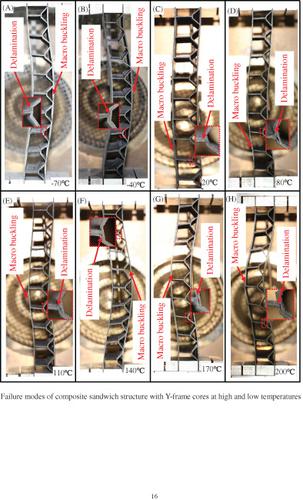当前位置:
X-MOL 学术
›
Polym. Compos.
›
论文详情
Our official English website, www.x-mol.net, welcomes your
feedback! (Note: you will need to create a separate account there.)
The effects of temperature on compressive responses and failure behaviors of composite Y-frame cores sandwich structure
Polymer Composites ( IF 4.8 ) Pub Date : 2021-08-31 , DOI: 10.1002/pc.26289 Weimin Jiang 1 , Xiaofei Yu 2 , Junmeng Zhou 3 , Jiayi Liu 1, 4 , Wei Huang 1
Polymer Composites ( IF 4.8 ) Pub Date : 2021-08-31 , DOI: 10.1002/pc.26289 Weimin Jiang 1 , Xiaofei Yu 2 , Junmeng Zhou 3 , Jiayi Liu 1, 4 , Wei Huang 1
Affiliation

|
The temperature has an important effect on mechanical behaviors of composite Y-frame cores sandwich structure. Therefore, the in-plane compressive behaviors of this structure should be thoroughly studied before it is used in engineering structures. The in-plane compressive tests for Y-frame cores sandwich structure were carried out within the temperature ranged from −70°C to 200°C. The load–deformation curves, deformation modes, and failure load of sandwich structure at various temperatures were compared and discussed. The results revealed that the deformation modes, load–deformation curves, and failure load were closely associated with the testing temperature. The cryogenic temperature caused the increasing of the failure load of Y-frame cores sandwich structure. However, the high temperature caused the degradation of the failure load of Y-frame cores sandwich structure. The in-plane compressive failure load increased from 11.78 to 14.82 kN as the testing temperature fell from 20°C to −70°C while the in-plane compressive failure load decreased from 11.78 to 2.06 kN as the testing temperature increased from 20°C to 200°C. The theoretical expression was also given to forecast the compressive failure load, and the theoretical results would be compared with the experimental results.
中文翻译:

温度对复合Y型框架芯夹层结构压缩响应和破坏行为的影响
温度对复合Y型框架芯夹层结构的力学行为有重要影响。因此,在将其用于工程结构之前,应彻底研究该结构的面内压缩行为。Y型框架芯夹层结构的面内压缩试验在-70°C至200°C的温度范围内进行。比较和讨论了夹层结构在不同温度下的载荷-变形曲线、变形模式和破坏载荷。结果表明,变形模式、载荷-变形曲线和破坏载荷与试验温度密切相关。低温导致Y型框架芯夹层结构破坏载荷增加。然而,高温导致Y型框架芯夹层结构破坏荷载下降。随着测试温度从 20°C 下降到 -70°C,面内压缩破坏载荷从 11.78 kN 增加到 14.82 kN,而随着测试温度从 20°C 升高,面内压缩破坏载荷从 11.78 kN 下降到 2.06 kN到 200°C。还给出了预测压缩破坏载荷的理论表达式,并将理论结果与实验结果进行了比较。
更新日期:2021-11-09
中文翻译:

温度对复合Y型框架芯夹层结构压缩响应和破坏行为的影响
温度对复合Y型框架芯夹层结构的力学行为有重要影响。因此,在将其用于工程结构之前,应彻底研究该结构的面内压缩行为。Y型框架芯夹层结构的面内压缩试验在-70°C至200°C的温度范围内进行。比较和讨论了夹层结构在不同温度下的载荷-变形曲线、变形模式和破坏载荷。结果表明,变形模式、载荷-变形曲线和破坏载荷与试验温度密切相关。低温导致Y型框架芯夹层结构破坏载荷增加。然而,高温导致Y型框架芯夹层结构破坏荷载下降。随着测试温度从 20°C 下降到 -70°C,面内压缩破坏载荷从 11.78 kN 增加到 14.82 kN,而随着测试温度从 20°C 升高,面内压缩破坏载荷从 11.78 kN 下降到 2.06 kN到 200°C。还给出了预测压缩破坏载荷的理论表达式,并将理论结果与实验结果进行了比较。











































 京公网安备 11010802027423号
京公网安备 11010802027423号